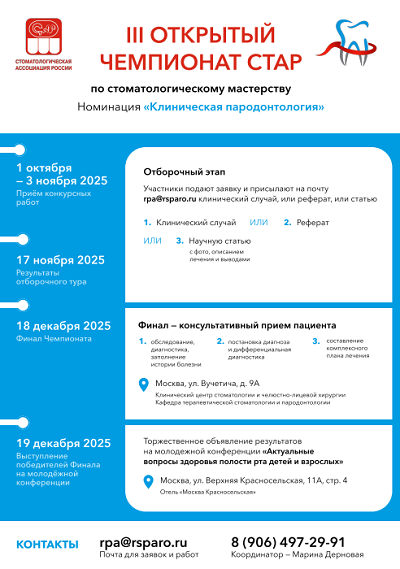Стеклоиономеры: оптимальный выбор для педиатрической стоматологии?
https://doi.org/10.25636/PMP.3.2018.3.5
Аннотация
Об авторах
Т. . ТрансоРоссия
К. . Дельфос
Россия
К. . Левер
Россия
М. . Ломэль
Россия
М. . Жайе
Россия
Список литературы
1. Blique M. Restaurations partielles directes: les ciments verre ionomère. In Médecine buccodentaire conservatrice et restauratrice. Espace ID. Concepts. 2014. 176p.
2. Agence Nationale de Sécurité du Médicament et des produits de santé. Le mercure des amalgames dentaires. Actualisation des données. Avril 2015. 93p.
3. Agence Nationale de Sécurité du Médicament et des produits de santé. Le mercure des amalgames dentaires. Recommandations, à l’attention des professionnels de santé, à respecter lors de l’utilisation des amalgames dentaires. Décembre 2014. 4p.
4. Lohbauer U et al. Strength and wear resistance of a dental glass ionomer cement with a novel nanofilled resin coating. Am J Dent 2011; 24 (2): 124–128.
5. Dursun E. Les ciments verres ionomères à haute viscosité. Partie 1 — Présentation, composition et propriétés. Biomatériaux cliniques 2016; 1 (1): 26–32.
6. Hoshida S et al. Effect of conditioning and aging on the bond strenght an interfacial morphology of glass-ionomer cement bonded to dentin. J Adhes Dent 2015; 17 (2): 141–146.
7. Kuhn E, Chibinski AC, Reis A, Wambier DS. The role of glass ionomer cement on the remineralization of infected dentin: an in vivo study. Pediatr Dent 2014; 36 (4): 118–124.
8. Basso M et al. Glassionomer cement for permanent dental restorations: a 48-months, multi-centre, prospective clinical trial. Stoma Edu J 2015; 2 (1): 25–35.
9. de Amorim RG et al. Amalgam and ART restorations in children: a controlled clinical trial. Clin Oral Investig 2014; 18 (1): 117–124.
10. Mickenautsch S, Yengopal V. Failure rate of atraumatic restorative treatment using highviscosity glass-ionomer cement compared to that of conventional amalgam restorative treatment in primary and permanent teeth: a systematic review update — II. J Minim Interv Dent 2012; 5: 213–72.
11. Gurgan S et al. Four-year randomized clinical trial to evaluate the clinical performance of a glass ionomer restorative system. Oper Dent 2015; 40 (2): 134–143
12. Webman M et al. A retrospective study of the 3-year survival rate of resin-modified glassionomer cement class II restorations in primary molars. J of Clin Ped Dent 2016; 40 (1): 8–13.
13. Klinke T et al. Clinical performance during 48 months of two current glass ionomer restorative systems with coatings: a randomized clinical trial in the field. Trials 2016; 17 (1): 239.
14. Bao Ying Liu, Xiao Y, Hung Chu C, Chin Man LO E. Glass ionomer ART sealant and fluoride-releasing resin sealant in fissure caries prevention -results from a randomized clinical trial. BMC Oral Health 2014; 14: 54.
15. Mickenautsch S, Yengopal V. Caries-preventive effect of high viscosity glass ionomer and resin-based fissure sealants on permanent teeth: a systematic review of clinical trials. PLoS One 2016; 11 (1): e0146512.
16. Diem VT et al. The effect of a nano-filled resin coating on the 3-year clinical performance of a conventional high-viscosity glass-ionomer cement. Clin Oral Investig 2014; 18 (3): 753– 759.
17. Dursun E et al. Restaurations aux ciments verre ionomère (CVI). In Fiches pratiques d’odontologie pédiatrique. Ed. Cdp. 2014. 347p.
18. Fragelli CM et al. Molar incisor hypomineralization (MIH) conservative treatment management to restore affected teeth. Braz Oral Res 2015; 29 (1): 1–7.
19. Hilgert L et al. Is hight-viscosity glass-ionomer cement a successor to amalgam for treating primary molars? Dental materials 2014; 30 (10): 1172–1178.
Рецензия
Для цитирования:
Трансо Т., Дельфос К., Левер К., Ломэль М., Жайе М. Стеклоиономеры: оптимальный выбор для педиатрической стоматологии? Стоматология детского возраста и профилактика. 2018;18(3):28-34. https://doi.org/10.25636/PMP.3.2018.3.5
For citation:
, , , , Glass ionomers: the material of choice in paediatric dentistry? Pediatric dentistry and dental prophylaxis. 2018;18(3):28-34. (In Russ.) https://doi.org/10.25636/PMP.3.2018.3.5




































